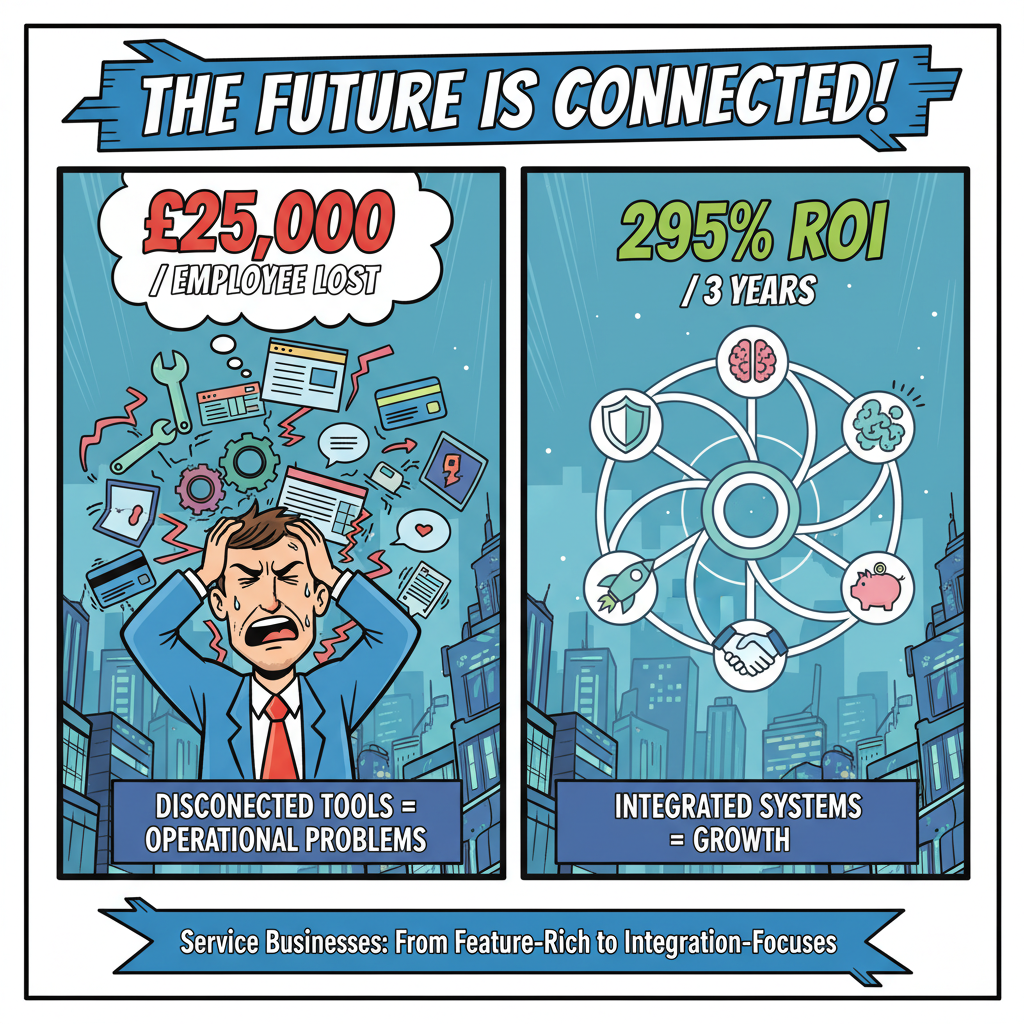
The Silent Revolution: Why Service Businesses Are Choosing Integration Over Innovation
Service businesses are shifting from feature-rich platforms to integration-focused systems. This change addresses real operational problems: disconnected tools cost SMBs £25,000 per employee annually, whilst integrated systems deliver 295% ROI within three years. The future belongs to businesses that prioritise how systems connect, not how many features they have.
TL;DR:
Why Integration Beats Innovation
80% of SMBs underuse their digital tools. The problem isn't capability. It's connection.
41% of employees manually transfer data between systems, wasting hours each week. Businesses with four or more integrations see 35% higher retention. Five or more? Nearly 100% retention.
The numbers tell a clear story. Systems that talk to each other keep businesses running. Systems that don't create expensive problems.
What I'm Seeing in the Market
Three years ago, business owners asked me about the latest marketing tools. They wanted the best features, the most advanced AI, the shiniest interface.
Now they ask different questions.
"Will this connect to what I already have?"
"How long until this works together?"
This shift tells me something fundamental is changing.
Why the Feature Arms Race Failed
Software companies spent years competing on features. Each platform added more capabilities, more modules, more options.
The logic seemed sound. More features meant more value.
But I kept seeing the same pattern. Clients would sign up for platforms with hundreds of features and use five of them. The rest sat dormant, creating complexity without delivering results.
Research backs this up: 80% of small firms don't fully use available digital tools.
One client juggled nine different cloud tools. Each one worked fine alone. Together, they created chaos. Data lived in silos. Staff manually transferred information between systems. Simple tasks required logging into multiple platforms.
Key insight: More tools often means less productivity when systems don't connect.
What Real Integration Looks Like
Integration isn't about connecting everything to everything.
Real integration means your systems work as one unit. When a lead comes in, your CRM, email platform, and booking system all know about it. When a customer makes a purchase, your invoicing, inventory, and follow-up sequences update automatically.
No manual data entry. No switching between platforms. No wondering if information synced properly.
I apply the 80/20 principle here. Twenty percent of your integrations deliver 80% of your operational efficiency.
When systems talk to each other, businesses stick around. When they don't, businesses leave.
Key insight: Integration quality matters more than integration quantity.
The Real Cost of Disconnected Systems
Disconnected systems don't just slow you down. They actively drain resources.
Team efficiency drops when staff become human data conduits. They spend hours copying information from one system to another.
The financial impact adds up fast:
Manual data transfer creates errors
Errors create rework
Rework creates delays
Delays create unhappy customers
One education provider I worked with had this exact problem. Their marketing, CRM, and payment systems didn't talk to each other. Staff spent 15 hours per week just moving data around.
We built automated follow-up systems that connected everything. The result? Predictable cash flows even during an economic downturn. Not because they worked harder. Because their systems finally worked together.
Most organisations achieve positive ROI within 6-13 months. Azure Integration Services users report 295% ROI over three years with a six-month payback period.
Key insight: Integration investments pay for themselves quickly through eliminated manual work and reduced errors.
Why This Shift Matters Now
The integration-first movement responds to real market pressure.
SMBs now juggle an average of nine cloud tools. Each tool requires setup, maintenance, and training. Each integration point creates potential failure.
Meanwhile, customer expectations keep rising. They want instant responses. They want personalised service. They want seamless experiences across every touchpoint.
You can't deliver that with disconnected systems.
Integration is now one of the Top 10 SMB Technology Trends for 2025, sitting alongside AI adoption and cybersecurity. Integration moved from a nice-to-have to a strategic priority.
The API-first movement supports this shift. 11% of organisations now define themselves as API-first leaders, up from 8% in previous years. These companies outperform their competitors because they build integration into their foundation.
Key insight: Integration has moved from technical concern to strategic business priority.
How to Evaluate Integration-First Platforms
When I evaluate technology for clients now, I ask different questions:
Does it have robust APIs? If a platform doesn't expose its data through clean APIs, you'll regret that choice later.
What pre-built integrations exist? Building custom integrations costs time and money. Pre-built connections to common platforms save both.
How does it handle data flow? Real-time sync or batch updates? Bidirectional or one-way? These details matter when systems need to stay in sync.
Does it scale without breaking? Integration complexity grows exponentially. A platform that handles five integrations smoothly might collapse under fifteen.
Key insight: Evaluate platforms on integration capability first, features second.
Your Decision Framework
I use a simple framework when helping clients choose between feature-rich platforms and integration-focused solutions:
First, map your current systems. List every tool you use and what data flows between them. This reveals your integration gaps.
Second, identify your critical data flows. Which information needs to move between systems in real-time? Which waits? Not all integrations are equally important.
Third, calculate the manual work cost. How many hours per week do staff spend moving data around? Multiply that by your average hourly cost. That's your integration opportunity.
Fourth, evaluate platforms on integration capability first. A platform with fewer features but better integration often delivers more value than a feature-rich island.
This framework eliminates the technology overwhelm I see constantly. High-growth companies make faster decisions by evaluating fewer variables. They focus on what matters and ignore the rest.
Key insight: A structured evaluation process reveals the true cost of disconnected systems.
What This Means for Your Business
The integration-first revolution changes how you should think about technology investments.
Stop asking "What does this tool do?" Start asking "How does this tool connect?"
Stop comparing feature lists. Start mapping integration capabilities.
Stop building technology stacks. Start building technology ecosystems.
The businesses that make this shift gain a significant advantage. Their systems work harder whilst their staff work smarter. They scale operations without scaling headcount. They deliver better customer experiences without adding complexity.
Small businesses with integrated systems compete effectively against larger competitors. They move faster because manual processes don't bog them down. They serve customers better because information flows seamlessly.
Marketing automation alone delivers 544% ROI. When you add proper integration, those returns compound. Systems that work together create value that isolated tools never deliver.
Key insight: Integration turns individual tools into a competitive advantage.
The Path Forward
Service businesses are voting with their wallets, choosing integration over innovation.
This doesn't mean innovation stops. It means innovation happens within an integrated framework. New features matter when they enhance the ecosystem, not when they create new silos.
For SMBs, this shift levels the playing field. You don't need enterprise budgets to compete. You need smart integration that makes your existing tools work together.
The technology paradox that plagued small businesses is resolving. Not through more tools, but through better connections between the tools you already have.
I've built my entire approach around this principle. NEXUSPRO exists because I saw too many service businesses drowning in disconnected systems. They needed enterprise-level integration at small business prices.
The future belongs to businesses that understand this shift. Not the ones with the most features, but the ones with the best integration.
Frequently Asked Questions
How do I know if my business needs better integration?
Calculate how many hours per week your team spends manually transferring data between systems. If it's more than five hours, you have an integration problem costing you real money.
What's the typical ROI timeline for integration investments?
Most organisations achieve positive ROI within 6-13 months, with some seeing returns in as little as six months through reduced manual work and fewer errors.
Should I replace all my tools with an all-in-one platform?
Not necessarily. The right choice depends on your specific needs. An all-in-one platform works well if it covers your core functions. Otherwise, focus on tools with strong integration capabilities that work well together.
How many integrations does my business actually need?
Apply the 80/20 principle. Identify the 20% of integrations that will eliminate 80% of your manual work. Research shows businesses with four or more key integrations see 35% higher retention.
What's the difference between API integration and native integration?
Native integrations are pre-built connections between platforms that work out of the box. API integrations require custom development. Native integrations are faster and cheaper to implement for most SMBs.
How do I prioritise which systems to integrate first?
Start with systems where data flows most frequently. Typically, this means connecting your CRM to your email platform, booking system, and payment processor. These connections eliminate the most manual work.
Will integration make my business too dependent on technology?
Integration actually reduces technology dependence by making systems work automatically. Your team spends less time managing technology and more time serving customers.
What happens if one integrated system fails?
Quality integration platforms include failsafes and data backup. The risk of system failure is lower than the daily cost of manual data transfer and human error in disconnected systems.
Key Takeaways
Integration delivers measurable ROI: Most businesses achieve positive ROI within 6-13 months, with some reporting 295% ROI over three years.
Disconnected systems are expensive: Poor collaboration costs businesses £25,000 per employee annually through manual work, errors, and delays.
Integration drives retention: Businesses with five or more integrations see nearly 100% retention because connected systems deliver consistent value.
Evaluate integration first: A platform with fewer features but strong integration capabilities often delivers more value than a feature-rich isolated tool.
Start with critical data flows: Apply the 80/20 principle to identify the 20% of integrations that will eliminate 80% of manual work.
Integration is now strategic: Integration ranks among the Top 10 SMB Technology Trends for 2025, moving from technical concern to business priority.
The shift is happening now: Service businesses are choosing platforms based on how well they connect, not how many features they offer.





